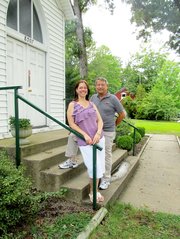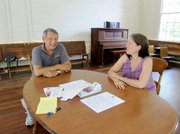This archival screen-shot photo was taken around 1928-1929, right after the school was constructed. The girl in the photo is Minerva Young Hawkins, one of the school’s first students. The photo is part of a video made by the Sydenstricker Church regarding the church history. Photo Contributed
Nearly four years after deciding to shut down the popular elementary school because of shrinking enrollment, mounting parental pressure and ardent emotional appeals swayed Fairfax County’s School Board to re-open the rural community school.
That meeting was held in September 1937, when a delegation from the community—led by teacher Albytene Roberts—again requested the reopening of Pohick School #8, commonly known as The Sydenstricker Schoohouse in Springfield.
A community hub since it was built in 1928, the board agreed to open the school, as long as it could maintain an attendance of at least 20 students. The school closed for the final time in June 1939, when the Works Project Administration (WPA) built the new, larger Burke Elementary School.
“I know. When you read the history, especially the newspaper accounts of the time, it sounds like we’re talking about the debate over Clifton Elementary School,” said Lisa Friedrich Becker, smiling as she recounts some of the history of what many know today as the “little red schoolhouse.”
As president of the Upper Pohick Community League (UPCL), Becker said preserving the schoolhouse has become her “great passion.”
Thanks to the efforts of Becker, and other league members, the historic school is undergoing another rebirth.
Glimpses of Sydenstricker’s Past
February 17, 1932 (from the meeting minutes of the School Board):
“The clerk presented a letter from the school’s teacher, Miss Elizabeth Gates, suggesting the suspension of twelve year old, Ewing Crawn. Miss Gates stated that Ewing ‘refused to stay in one day, and when I started to whip him he broke the switch and struck me.’ The boy was suspended, and the board expressed their belief that it was generally bad policy to suspend such young children; however, in small schools such as Pohick, it would do more harm than good to keep such a child in school.”
*Lindy Neish, a lifelong resident of Springfield, attended the Pohick School (which by then had come to be known as the Sydenstricker School) in the 1930s. In 1989, he recalled that the boys had to collect firewood for the stove and fresh water from the spring. A 1933 report in “The Herndon Observer” notes that the community appealed to the school board for a well at the schoolhouse, so the children would not be forced to carry water “through rain and mud, year in and year out.” This well was never constructed.
*In 1943, “The Fairfax Herald” reported that the “Old School House” at Sydenstricker had been converted into a center for making surgical dressing to support the war effort: “The bell at the little old school house near Sydenstricker rang this past week for the first time in a number of years. This time it was not calling to children, since it is no longer needed for school purposes, but calling to the adults in the community who have dedicated this quaint building to a need of the hour—a center for Red Cross surgical dressing.”
ON AUG. 22, the Sydenstricker Schoolhouse was placed on the National Register of Historic Places, a prestigious honor that helps assure the school’s preservation. For nearly four years, Becker researched the history, interviewed descendants, gathered and archived photos, and dotted the i’s and crossed the t’s for the rigorous National Register application.
“I've told people, and it's the God-honest truth, that other than my son, I feel like the National Register is the greatest accomplishment of my life. I feel like it is my legacy, and I'm so proud of it,” Becker said.
“Lisa deserves all the credit for making this happen,” said past UPCL president Manuel Pablo, who has been a member of the league since 1972. “The schoolhouse harkens back to an interesting time. I remember when the first Supervisor Herrity, Jack Herrity, held community meetings here.”
“This is a community treasure,” said Supervisor Pat Herrity (R-Springfield). “It’s where political debates used to be held, and where the Springfield District Council is now holding some of its meetings.”
Situated on just under an acre of land, the front-gabled school sits parallel to Hooes Road, once a farm-to-market wagon road, and adjacent to the Sydenstricker Methodist Chapel and cemetery.
“I think the site, the fact that some of the trees are 100-years-old, and it’s next to the chapel and cemetery gives it an authenticity that you don’t find anymore,” Becker said.
The interior of the building, approximately 805 square feet, includes one large room (the original schoolroom) and a small cloakroom, which was converted into a kitchen in the late 1950s.
The one-story building retains many original features, including a combination storage shed and three-hole privy. The simple, classic architectural traits of the Sydenstricker School are characteristic of other historic Fairfax County schoolhouses, most notably the Legato School, City of Fairfax and the Laurel Grove School in Alexandria.
Becker said her 4-year-old son, Oliver, likes to hear her ring the school bell, which is original to the building.
“This is as original as it gets,” Pablo said. “Nearly everything here is in its original condition…We want to restore it as a community asset.”
Becker said the UPCL, which purchased the school from Fairfax County in 1954, has launched a “save the community treasure” campaign to do just that.
“We want to preserve the schoolhouse, and to make it a community hub once again. I want to drive by and see the lights on and have this be a special place for events, celebrations, community meetings.”
How to Help Save the Schoolhouse
*To find out more about efforts to restore the Sydenstricker Schoolhouse, or to make a donation, go to www.sydenstrickersc….
*On Saturday, Sept. 22, The Upper Pohick Community League is hosting a free community coffeehouse, featuring live music. Beverages and desserts will be available for a small donation. For more information, go to info@sydenstrickers….
BUT TO ACCOMPLISH that, the league needs donations for the laundry list of repairs and replacements, particularly to upgrade the electrical wiring, remove the lead paint and replace the HVAC system. Becker said the cost could easily be more than $100,000, because many of the replacements need to be historically authentic. For example, the tin roof needs to be replaced by a tin roof.
“We had a mother’s playgroup that wanted to meet here, but before we can do that, we have to remove the lead paint, and that costs $15,000,” Becker said.
Both Becker and Pablo are passionate about the schoolhouse, and confident of its return.
“When I come here, I feel like I’m connected to the people who have been here. We desperately want to save this building,” Becker said. “We see the vision for what we can do, but we can’t get there without a lot of help.”




